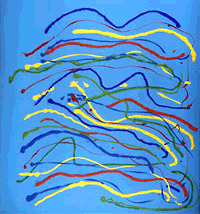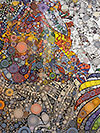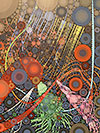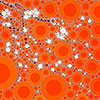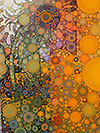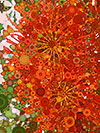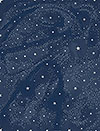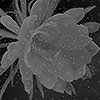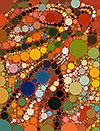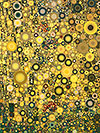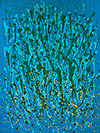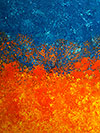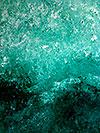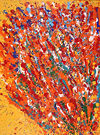Art
Artist's Statement
 Since the early 2000s, my artwork has involved the creation of abstract paintings in which I try to find an art equivalent of the musical motion - both structurally and in color. This is why I call my work "Visual Music."
Since the early 2000s, my artwork has involved the creation of abstract paintings in which I try to find an art equivalent of the musical motion - both structurally and in color. This is why I call my work "Visual Music."
Musical forms, melodies, harmonies, textures, dynamics and tempos are all inspiration for my art. My palette follows the principle of contrast and repetition -- the paramount principle in musical compositions. Thus, I attempt to both create the connection between art and music and at the same time transcend the boundaries of these two cultural mediums.
Watch The Mural
In The Mural, I play the Second Movement, “Largo e mesto,” from Beethoven's Sonata No. 7, Op. 10, No. 3 while footage of myself and other artists painting a mural is juxtaposed.
Collection 1 - Symphony in 4 Movements - 2015
Symphony in 4 Movements is my latest work of my long-term project "Visual Music." The series consists of 30 digitally generated prints. The sequence follows the musical ideas and structures of the symphonic cycle. In this art score, I employ thematic development, thematic transformation and other methods common to classical music. I also employ the principles of musical form to structure the movements of the series.
The movements contrast one another, with each movement having a different character.
The first movement, "Motions," is intricate, pensive and somewhat polyphonic. It is composed in ternary form (the three-part form) (see the following excerpts).
The second movement, "Pastorale," explores the world of nature and its colors and is structured in through-composed form. (see the following excerpts).
The third movement, Scherzo, is monochromatic and of a playful and sparkling character. I subtitle it "The Radiance of the Night." It is composed in ternary form. (see the following excerpts).
The fourth movement, Finale, is joyful, optimistic and energetic, with the motion of color as the driving force of onward movement. It is composed in sonata form. (see the following excerpts).
As a progression of events, this symphonic cycle introduces the element of time into the art's two-dimensional space. At the same time, the audience can see the temporal process as one object in space. They can see each movement and the entire symphony as the whole, if they step back and observe it as one. Thus, the sequence creates the spacial-temporal structure, the space-time continuum, synergizing the space and time into the unified entity.
Collection 2 - Visual Music Work
Exhibitions
2015
MIHAW Center, New York. September-December (solo).
2013
The Museum of Russian Art, Jersey City, NJ. March
2010
25 CPW Gallery, New York. May
BoConcept, Dumbo, Brooklyn, NY. May-June
2008
Brooklyn Conservatory of Music, New York. November (solo)
The TNC Gallery, New York City. May-June
A featured artist in the Spring 2008 issue of the Journal of Esoteric Psychology.
2007
The C. Booth Library, Newtown, Connecticut.
The C. Booth Library, Newtown, Connecticut (solo)
2006
Lexington Gardens, Newtown, Conn.
Featured Works:
Articles
Will Piano Lessons Make
My Child Smarter?
Lincoln Center Presents: Vita Nuova, a New Opera by Vladimir Martynov
